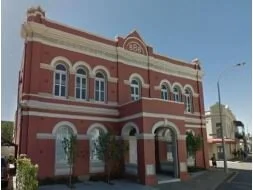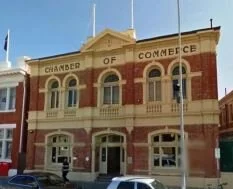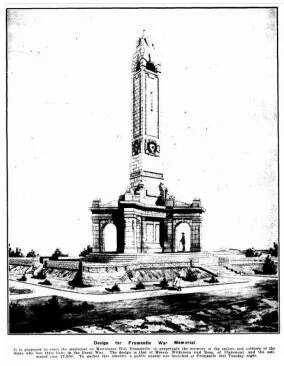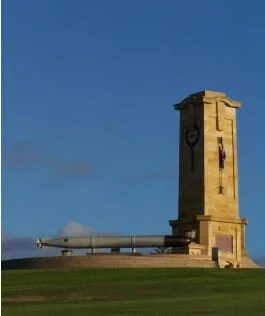Joseph Francis Allen
(1869-1933)
Joseph Francis Allen (1869-1933) was born 6 August 1869 at Perranzabuloe, Cornwall, England, son of William Allen, carpenter, and Salome, née Williams. Allen moved with his parents to Parramatta, New South Wales when he was 10 years old, and in 1884 was articled to Scottish-born architect Gordon McKinnon (1856-1922) in Sydney. Allen then worked for Rhodes & Co, civil engineers, and from 1894 for Henry Simon & Co, milling engineers.
In 1896 he moved to Western Australia where, after working as an assistant engineer on the Fremantle harbour works, he commenced practice as an architect in 1897. With two of his brothers acting as groomsmen, Joseph married Jean Symington Buntine at the East Fremantle Presbyterian Church in September 1900, and they had a daughter Janet in 1902. Living exclusively in the Fremantle area after arrival in WA, Allen was very active with civic, commercial and residential work around the port, but he also designed buildings at many other places around the Perth metropolitan area and in the State of Western Australia.
Some of Allen’s better-known individual works included the East Fremantle Town Hall (1899); a hall and offices at Midland Junction for the WA Locomotive Union (1903); two explosives magazines at Woodman’s Point for Elder & Shenton (1903); and the Fremantle Trades Hall (1904). In May 1907 Allen was commissioned by Smith & Wadham to prepare plans for the erection of a warehouse and offices in Bay Street (now 10 Elder Place), Fremantle and by October the building had been completed by Mr C. Moore. Allen and Moore had worked together on the number of building projects Fremantle including a factory and showrooms for Instone and Co, Essex Street (1906), and premises for Strelitz Bros in Henry Street (1906), Fremantle Golf Club House ( 1907). Allen called tenders in December 1911 for the Commercial Travellers' Club at 11 Cantonment Street Fremantle, in 1912 for the Chamber of Commerce at 16 Phillimore Street Fremantle, and in 1914 for the Vacuum Oil Company’s bulk oil store at West Perth. Allen may have designed earlier Vacuum Oil Company premises at 7 Pakenham Street Fremantle, and by 1919 at Thompson Road North Fremantle, a large warehouse, laboratory and office had been built for the company to the designs of Allen & Nicholas.
Around 1900, Allen established an important business relationship with the Hamburg-born brothers Paul and Richard Strelitz at Fremantle. The Strelitz’s first company buildings at 32 Mouat Street at Fremantle were designed by architects Cavanagh & Cavanagh and occupied in 1897, just as Allen Joseph Francis Allen by Dr John J. Taylor December 2016 commenced practice in WA on his own account. Extremely successful merchants, the Strelitz Bros, who amongst many import-export enterprises had an agency for Alfred Nobel’s Hamburg explosives company, purchased a property at 26 Mouat Street Fremantle in 1900, and Allen soon designed a warehouse for the site. He also produced bulk stores at South Fremantle for Strelitz Bros in 1902 & 1905, premises in Henry Street Fremantle during 1906, large business premises with frontages to Hay and Murray Streets Perth built in 1908 (sold in 1924 to the City of Perth), and the grand residence 'St Just' at 44 View Street Peppermint Grove for Richard Strelitz, occupied in 1910. In December 1911 Allen elevated the young but highly-talented Claude Henry Nicholas (1889-1966) to be a named partner in the practice Allen & Nicholas Architects.
One of Allen’s engineering achievements was the design and supervision in 1905 of the first steel ship built in WA, the 133 foot long Westralian, which amongst other journeys, was used for Fremantle to Rottnest Island voyages.
Allen was active in local and State politics throughout his time in WA. In 1903 he won a seat on the East Fremantle Town Council and held it, but for one year, until his death in 1933. He served as mayor in 1909-1914 and became property-owners' representative on the East Fremantle Tramways Board and a member of the board of the Fremantle Public Hospital. After an unsuccessful attempt in 1912, Allen entered State parliament in 1914 as a Liberal member for the West Province of the Legislative Council, but was defeated in the 1920 election.
In 1928 he became chairman of the Rottnest Island Board of which he was a foundation member in 1917, and in 1931 he was elected mayor of East Fremantle for the second time. He also held office in the Fremantle Municipal Tramways and Electric Lighting Board, Fremantle Chamber of Commerce (President 1921-1925 and 1933), and Royal Institute of Architects of Western Australia (President 1928-1929, 1932-1933).
Allen died suddenly on 23 May 1933, aged 63 years, probably of a heart attack, as a post-mortem examination found that ‘the right side of the heart was distended and there was a clot of blood in the right ventricle’. His body was found in the Swan River at East Fremantle, and the coroner found no suspicious circumstances. Coincidentally, another architect, Ernest Hugh Hamilton, had died in 1928 by falling into the Swan River at Barrack Street, Perth after a medical incident.
Survived by daughter Janet, Joe Allen was buried in the Presbyterian section of the Fremantle cemetery, joining Jean who had died in 1912 aged 51 years. Amongst many other community service projects, Allen was the honorary architect for the committee that appointed Pietro Porcelli to sculpt the 1911 C.Y. O’Connor memorial at Fremantle; Allen & Nicholas were the honorary architects for the First World War Memorial on Monument Hill, Fremantle. No doubt with recognition of the importance of Allen’s standing within the community; Claude Nicholas continued the practice name for some 30 years following Allen’s passing. This article contains just a ‘snapshot’ of the works of Allen (& Nicholas) – a notable Western Australian architect whose influence and contributions, particularly at Fremantle, remain to be thoroughly documented.
This biography was written by Dr John J. Taylor (architect) in December 2016. We thank him for sharing his information and research. You can see the original article (and his references) on his website: (reference)
You can also read a more personal biography on the www.streetsofeastfreo website ( reference)
Joseph Francis Allen, RIAWA c.1930










